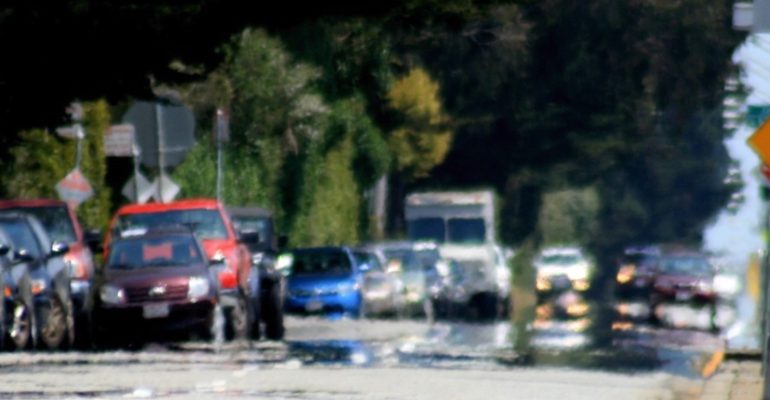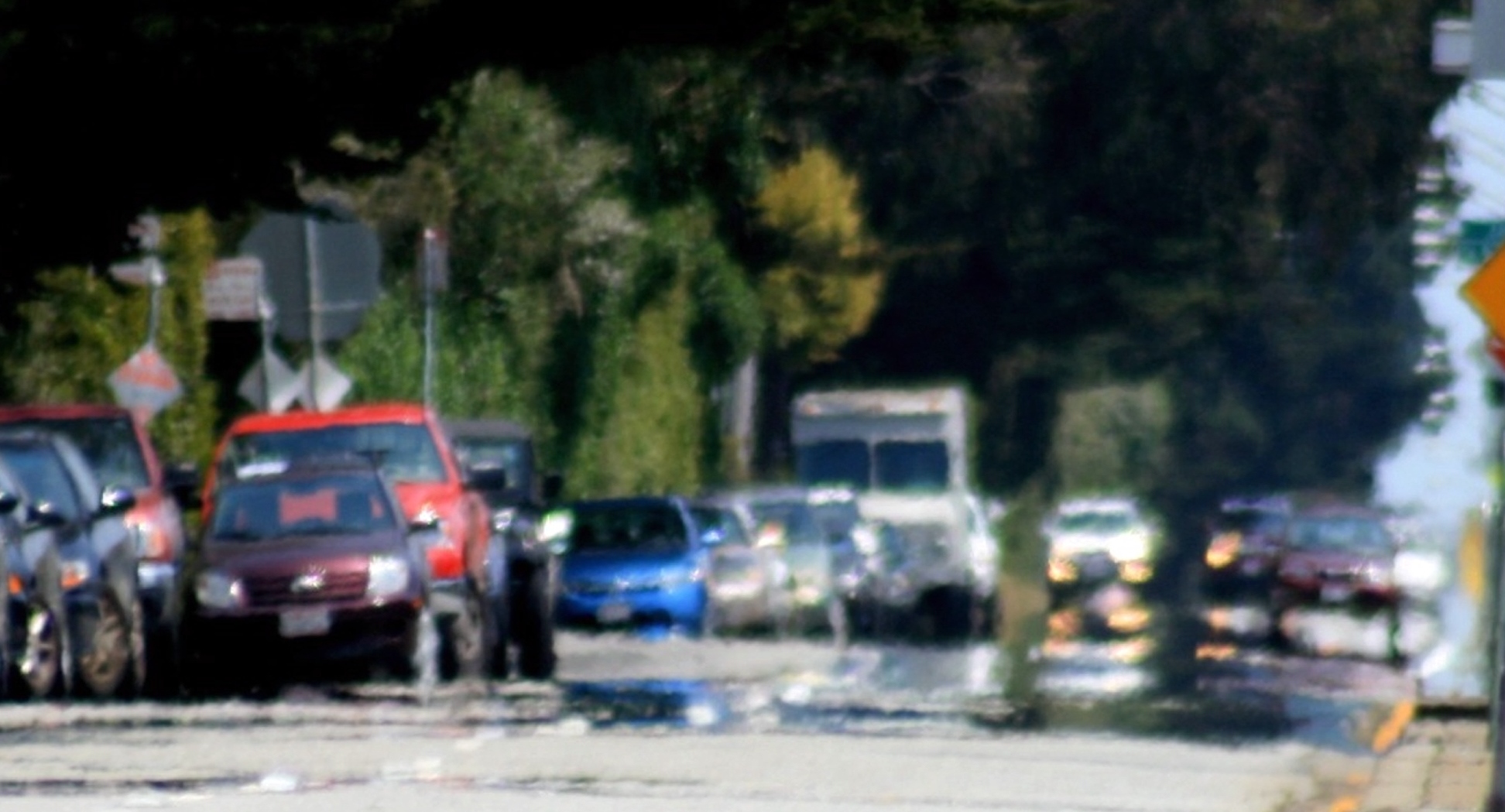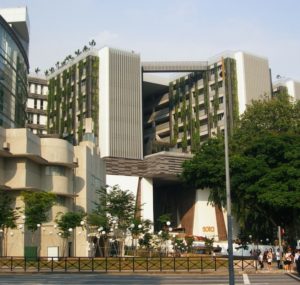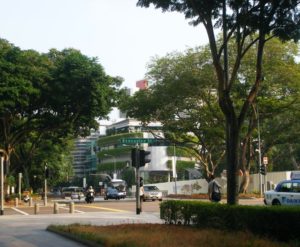

The shimmer of a heat mirage shows how a hard road surface increases urban temperatures by radiating heat into the air. Photo: Brocken Inaglory, CC BY-SA
Our cities are getting hotter, more crowded and noisier. Climate change is bringing more heatwaves, placing pressure on human health, urban amenity, productivity and infrastructure.
Urban residents naturally want to stay cool. Air conditioning is the usual choice, but it can be expensive to run. Air conditioning also adds carbon pollution, creates noise and can make outdoor spaces hotter.
So what else can we do to manage increasing urban heat? And who has the ability to act?
Urban planners are increasingly involved in developing and delivering urban greening strategies. While it seems like a “no brainer” to green cities, our international research shows that planners are not always comfortable with this idea.

Green walls cooling a building in Singapore
However, green infrastructure – including street trees, green roofs, vegetated surfaces and green walls – is emerging as a viable way to help cities adapt to increased heat. Uptake of these technologies is slowly increasing in many cities around the world.
The Australian government has recognised this trend. An agenda to green Australia’s cities is now in place. Stated aims include managing climate change impacts, reducing urban heat, improving urban well-being and increasing environmental performance.
This urban greening agenda is part of the Clean Air and Urban Landscapes hub, under the National Environmental Science Program.
Benefits of urban greening

Street trees and green walls helping to reduce urban temperatures. Tony Matthews
The broadening appeal of green infrastructure is helped by the fact it offers multiple benefits.
For example, shading from strategically placed street trees can lower surrounding temperatures by up to 6℃, or up to 20℃ over roads. Green roofs and walls can naturally cool buildings, substantially lowering demand for air conditioning. Green infrastructure can also provide habitat for wildlife, recreational opportunities for people, better management of stormwater runoff and improved urban aesthetics.
Hard surfacing, including concrete, asphalt and stone, is common in cities. It can increase urban temperatures by absorbing heat and radiating it back into the air. Green infrastructure can minimise this difficulty as it better regulates ambient air temperatures. Foliage allows local cooling through evapotranspiration, where plants release water vapour into the surrounding atmosphere.
Why planners are cautious
Our research examined urban planners’ attitudes towards green infrastructure use in Australia, England and Ireland. We found that planners are broadly aware of green infrastructure as an urban intervention. They understand its use, application and capacity to provide multiple benefits, especially in terms of managing urban heat.
The planners we interviewed, while recognising the potential value of green infrastructure, strongly cautioned that delivering the technology can be an uncertain process. The biggest barrier cited was that planning departments are not experienced with green infrastructure.
Put simply, they tend to avoid it because it has not traditionally featured on planning agendas. Like any new planning endeavour, green infrastructure can create institutional, legal, economic, social and environmental challenges.
Some of the biophysical challenges associated with green infrastructure delivery are novel. Choosing appropriate forms of vegetation, for example, may be difficult. Decisions must be made based on prevailing climactic conditions, drainage capacity and species growth patterns.
Will root systems damage buildings or underground utility networks? Might trees topple during storms and damage houses? Are roofs strong enough to support a rooftop garden? Planners may not be able to answer these questions, which creates a need for external experts to advise them.
Our findings also highlight socio-political factors as barriers. These include governance concerns such as the political context in which planning decisions are made.
Management issues also feature. Chief among these are government commitments to budget for green infrastructure delivery and management.
Planners are also wary of public involvement. They know that public sentiment about green infrastructure can be influenced by perceptions of modified access, changed use, or loss.
What can be done?
The urgency for providing urban green infrastructure increases as climate change makes our cities hotter. Our research suggests the principal task for planners is to overcome embedded practices and to accept green infrastructure as an emerging but permanent urban feature.
This will not be easy. For example, a decision to use a road easement for green infrastructure may require multiple meetings with other government departments, utility companies and residents. Planners will need to coordinate these, manage stakeholder expectations and ensure cost sharing where necessary.
Legal, economic, social and environmental issues will require innovative solutions.
Planners will increasingly be tasked to deliver green infrastructure in cities. They will need to be clear on its value, be prepared to lead its delivery and learn from new challenges and solutions encountered along the way.
Urban residents all over the world stand to benefit if planners can successfully meet this challenge, particularly as hotter temperatures threaten urban comfort and habitability.
![]()
Tony Matthews, Lecturer in Urban & Environmental Planning, Griffith University and Jason Byrne, Associate Professor – Environmental Planning, Griffith University
This article was originally published on The Conversation. Read the original article.
Republished by Redlands2030 – 10 March 2016
Please note: Offensive or off-topic comments will be deleted. If offended by any published comment please email thereporter@redlands2030.net
Planners don’t design buildings or infrastructure. Planners put forward the designs of architects and developers or assess these designs. If a green roofed building for example was to be proposed, there’s nothing stopping it from being approved unless there’s a building code which restricts it. The author’s barking up the wrong tree.
people assume “planners” are a generic group of professionals that have control over what development happens. This is so far from reality it makes me laugh. The technical planning people have only a limited involvement in an essentially political decision making process. Here in RCC there are no strategic land use planners making strategic decisions about where and how many urban areas are planned for the future. Council and State politicians decide where important urban release areas or significant developments are located. The State even takes it out of the control when they want (ie. Toondah Harbour). The developers then put in applications and the development assessment planners MUST consider them against the weasel words / performance criteria in the Planning Scheme. With a pro development council, those decisions always lean towards Yes, rather than No, with the overt or insidious support of the Council. For this issue “planners” know the value of a properly designed development with open space and trees, urban forests and proper urban design. They just never get a chance to approve any ! And this Council is not interested in encouraging good design – refer Ormiston / koala habitat.